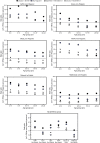Racial and Ethnic Disparities in COVID-19 Incidence by Age, Sex, and Period Among Persons Aged <25 Years - 16 U.S. Jurisdictions, January 1-December 31, 2020
- PMID: 33735165
- PMCID: PMC7976617
- DOI: 10.15585/mmwr.mm7011e1
Racial and Ethnic Disparities in COVID-19 Incidence by Age, Sex, and Period Among Persons Aged <25 Years - 16 U.S. Jurisdictions, January 1-December 31, 2020
Abstract
The COVID-19 pandemic has disproportionately affected racial and ethnic minority groups in the United States. Whereas racial and ethnic disparities in severe COVID-19-associated outcomes, including mortality, have been documented (1-3), less is known about population-based disparities in infection with SARS-CoV-2, the virus that causes COVID-19. In addition, although persons aged <30 years account for approximately one third of reported infections,§ there is limited information on racial and ethnic disparities in infection among young persons over time and by sex and age. Based on 689,672 U.S. COVID-19 cases reported to CDC's case-based surveillance system by jurisdictional health departments, racial and ethnic disparities in COVID-19 incidence among persons aged <25 years in 16 U.S. jurisdictions¶ were described by age group and sex and across three periods during January 1-December 31, 2020. During January-April, COVID-19 incidence was substantially higher among most racial and ethnic minority groups compared with that among non-Hispanic White (White) persons (rate ratio [RR] range = 1.09-4.62). During May-August, the RR increased from 2.49 to 4.57 among non-Hispanic Native Hawaiian and Pacific Islander (NH/PI) persons but decreased among other racial and ethnic minority groups (RR range = 0.52-2.82). Decreases in disparities were observed during September-December (RR range = 0.37-1.69); these decreases were largely because of a greater increase in incidence among White persons, rather than a decline in incidence among racial and ethnic minority groups. NH/PI, non-Hispanic American Indian or Alaska Native (AI/AN), and Hispanic or Latino (Hispanic) persons experienced the largest persistent disparities over the entire period. Ensuring equitable and timely access to preventive measures, including testing, safe work and education settings, and vaccination when eligible is important to address racial/ethnic disparities.
Conflict of interest statement
All authors have completed and submitted the International Committee of Medical Journal Editors form for disclosure of potential conflicts of interest. No potential conflicts of interest were disclosed.
Figures

References
-
- Kim L, Whitaker M, O’Halloran A, et al.; COVID-NET Surveillance Team. Hospitalization rates and characteristics of children aged <18 years hospitalized with laboratory-confirmed COVID-19—COVID-NET, 14 states, March 1–July 25, 2020. MMWR Morb Mortal Wkly Rep 2020;69:1081–8. 10.15585/mmwr.mm6932e3 - DOI - PMC - PubMed
MeSH terms
LinkOut - more resources
Full Text Sources
Other Literature Sources
Medical
Research Materials
Miscellaneous

